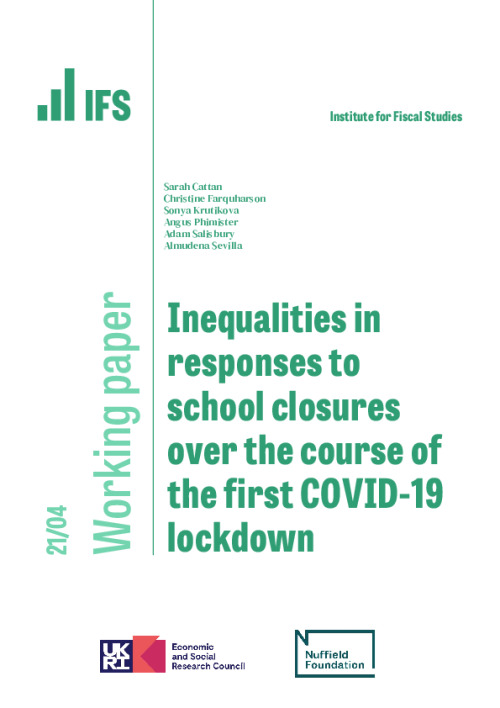On 20 March 2020, in response to rapidly escalating case numbers of COVID-19, English schools closed their gates to all but the children of essential workers and those children deemed most vulnerable. This decision was largely without precedent, and ushered in a period of home learning that schools, parents and pupils had little time to prepare for. This situation of nationwide closures continued until 1 June 2020, when schools began a phased reopening that prioritised children in Reception, Year 1, Year 6, Year 10 and Year 12. However, most reopening decisions were left to the discretion of the schools themselves, which created substantial variation in the school reopening experiences of different children.
This report analyses how these differences in school reopenings affected the learning experiences of English school children. To examine this, we leverage a unique panel of data, allowing us to observe how learning changed between April/May and June/July for around 650 school-aged children in England.[1] Crucially, the panel means that we observe children at two important points: first during the full national closure phase (29 April to 18 May) and then again during the phase of partial reopenings (26 June to 20 July). This allows us to examine how learning experiences changed for the same individual children, as they faced markedly different school reopening policies and changes in school provisions.
In particular, we examine how the learning experiences changed for children who were offered the chance to go to back school versus those who were not, and whether any benefits were confined to the children who actually took up the offer to return to the classroom. We also examine to what extent changes in learning time varied between children from different backgrounds, and whether these changes increased or offset previous inequalities. Finally, we examine how school learning provisions changed in response to school reopenings, to probe the extent to which there is a trade-off between in-school and remote provisions.
These questions are all particularly relevant now, given the UK is going through another phase of nationwide school closures. Our answers to them reveal important lessons for how the school reopening process should be managed this time around, and which groups of children government should be particularly mindful of.
Video
Key findings
- There is little evidence that pupils ‘settled in’ to home learning. Between wave 1 (April/May) and wave 2 (June/July), total learning time fell from 4 hours 10 minutes a day to 4 hours a day for primary school students and from 4 hours 35 minutes a day to 4 hours 15 minutes a day for secondary school pupils. Both of these are significantly below pre-pandemic levels, when primary school children spent around 6 hours a day on learning and secondary school children around 6½ hours a day.
- School reopenings helped to protect total learning time. Pupils who returned to school, at least part-time, in June/July saw their learning time rise. Primary school children who returned to school spent around 3 hours and 15 minutes at school on average, but cut back their other learning activities by much less than this. The overall result was that the children who returned to school benefited not just from a higher quality of learning time, but also a higher quantity: their daily learning time rose by over an hour compared with April/May.
- Pupils who were not prioritised for school reopenings saw their learning time fall further. At primary school, children who were not offered the chance to go back to school saw their learning time fall by around 40 minutes compared with their own learning time in April/May. At secondary school, the falls were even larger, at around 50 minutes a day. So in June/July, secondary school pupils who were not given the chance to return to school were spending around 20% less time on learning than in April/May and almost 50% less time than before the pandemic.
- Pupils who were not given the chance to go back to school at all saw their learning time fall by much more than their peers who chose to remain at home. This suggests that pupils benefited from being prioritised to return to school, even when they did not take up the offer. These pupils did not receive substantially better learning resources, but parents and children might have been encouraged to focus on home learning to keep up with peers in the classroom.
School reopenings
- We find no evidence that schools attended by better-off pupils were more likely to reopen. Around three-quarters of those in ‘priority’ years (in our sample, Reception and Years 1 and 10) were offered the chance to return to in-person schooling in June/July. Among other year groups, a quarter of pupils had the chance to go back to school. Schools were more likely to be open as time passed. But, encouragingly, we find that schools attended by less well-off children were no less likely to open last June/July.
- However, better-off parents were more likely to take up their school’s offer and send their children back. We find that only around half of primary school pupils who were given the opportunity to return to school (and three-quarters of Year 10s) had at least some in-person schooling in June/July. These decisions seem likely to reinforce existing inequalities: a child whose family was near the top of the pre-COVID equivalised earnings distribution (at the 90th percentile) was 22 percentage points more likely to take up the offer than a child whose family was near the bottom of the earnings distribution (10th percentile); most of this gap remains even when controlling for a wide range of other characteristics.
- We find that the primary reasons for parents’ caution relate to the health impacts of returning to school; however, disadvantaged families also cited a reluctance for their children to be the first ones to return to school as well as practical issues with transport.
- Schools seemed to be able to manage a concurrent programme of in-person and remote learning. In classes that reopened, schools did not pull back on their provision of active resources such as online classes. Some of these schools also increased their passive home learning provisions (e.g. home learning packs).
Inequalities
- School reopenings supported overall learning time. But the reluctance of some poorer families to send their children to school led to increased inequalities between poorer and richer children. Pupils from less well-off families were just as likely as their more advantaged peers to be offered the chance to return to school. However, they were substantially less likely to take up this offer.
- Even among those who returned to the classroom, richer children increased their learning time by more than their more disadvantaged peers. Since pupils from disadvantaged families were also less likely to have the home and school resources to make home learning effective, there is a real risk that an optional return to school would widen inequalities within a school year.
- By contrast, richer pupils who were not prioritised to return to school saw their learning time fall to levels similar to those of their poorer peers – reducing overall inequalities, but at the considerable cost of a worse learning experience for all.
Policy implications
- Central government had quite a bit of control over the return to school. While press coverage at the time highlighted the schools and local authorities going against the Department for Education’s guidance on reopening, in practice the partial reopening in June/July 2020 closely followed the national guidance, with prioritised year groups much more likely to be offered the chance to return.
- A phased programme of reopenings, with certain year groups prioritised, is likely to increase the inequalities between children of different ages. This is true even if not all pupils choose to return, since we find evidence that school reopenings protected learning time even among pupils who chose not to return to the classroom.
- Among students whose class reopened, allowing families to opt out of attending likely increased inequalities between poorer and richer students in the same year group. In June/July, fines for unexcused absences were suspended so that parents could choose whether or not to send their children back. If policymakers want to go down a similar route when reopening schools this spring, they should be aware of the undesirable consequences for inequalities.
- At a minimum, policymakers should engage consistently and proactively with local authorities, schools and families themselves to address concerns about the return to school. Among poorer families, the primary concerns are health risks to the child, health risks to the wider family and a reluctance to be the first to go back. Public health messaging about the risks of COVID-19 for children should be carefully communicated. Careful thought also needs to be given to provision for children living with high-risk family members. The fact that the vaccination roll-out is prioritising many of the most vulnerable should help mitigate some of these concerns.
[1] We focus on children in Reception and Years 1, 4, 5, 8, 9 and 10.













